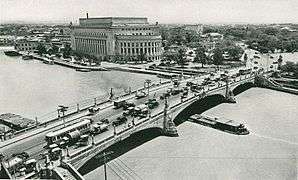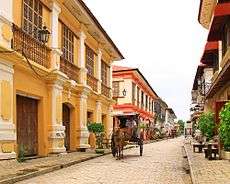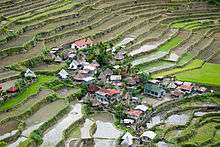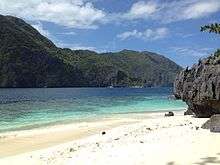Tourism in the Philippines
Tourism is an important sector for the Philippine economy. In 2015, the travel and tourism industry contributed 10.6% to the country's GDP.[2] The Philippines is an archipelagic country composed of 7,641 islands with 82 provinces divided in 18 regions. The country is known for having its rich biodiversity as its main tourist attraction.[3] Its beaches, mountains, rainforests, islands and diving spots are among the country's most popular tourist destinations. The country's rich historical and cultural heritage are also one of the attractions of the Philippines. Popular destinations among tourists are El Nido in Palawan, Davao, Boracay, Siargao, Cebu, Manila and many more.
As of 2015, 4.99 million Filipinos have been employed in the tourism sector and the government collected P227.62 billion pesos from foreign tourists.[4] The country attracted a total of 5,360,682 foreign visitors in 2015.[4]
Overview
Tourism makes an important part to the economy of the country. The growth of the economy had been into a major change since the end of the People Power Revolution up until to the present time because of the tourism growth.
In 2000, the Philippines' tourist arrivals totaled 2.2 million. In 2003, it totaled 2,838,000, a growth of almost 29%, and was expected to grow as much as 3.4 million in 2007. In the first quarter of 2007, the tourist arrival in the Philippines grew as much as 20% in same period last year. In 2011, the Department of Tourism recorded 3.9 million tourists visiting the country,[5] 11.2 percent higher than the 3.5 million registered in 2010.
In 2012, the Philippines recorded 4.27 million tourist arrivals, after the Department of Tourism launched a widely publicized tourism marketing campaign entitled "It's More Fun In the Philippines".[6]
The tourism industry employed 3.8 million Filipinos, or 10.2 per cent of national employment in 2011, according to data gathered by the National Statistical Coordination Board. In a greater thrust by the Aquino administration to pump billion to employ 7.4 million people by 2016, or about 18.8 per cent of the total workforce, contributing 8 per cent to 9 per cent to the nation's GDP.[7]
History

Tourism in the Philippines traces its origins during the ancient times when the first set of people chose to migrate through land bridges, followed by the second set of migrants from Indonesia, then the last migrants from Borneo Islands. All of those created their own kingdoms and tribes within the archipelago. Trade also became part of the tourism as Arabs, Indians and Chinese traded products and goods to the natives. When the islands became part of the territory of Spain, an influx of Spanish people migrated, (though still few compared to the ones migrated in South America due to distance of the country.)
The tourism industry first flourished during the late 19th to early 20th century due to the influx of immigrants from Europe and the United States. It was listed as one of the best country to visit in Asia aside from Hong Kong and Japan, earning the nickname "Pearl of the Orient Seas". The tourism declined during and after the World War II, leaving the country with a completely devastated capital. Most immigrants from Europe and US, and some other Filipinos were offered to emigrate to the US. The second wave of tourist influx flourished in the 1970s and early 1980s but declined in the mid 1980s due to the EDSA Revolution, with the average length of tourist stay falling from 12.6 days in earlier years to 8.9 days in 1988. In 1987, tourism growth was slower in the Philippines than in other Southeast Asian countries. About 1.2 million tourists visited the Philippines in 1992, which was a record high in the number of tourist visits since 1989.
Today, the tourism industry boomed again at the early part of the 2010s after the decline in the previous decade. The country saw an influx of tourists from all over the world, with the help of social media and the creative tagline, the tourism went at its peak and became one of the countries people wanted to visit in Southeast Asia with having 3,590,038 million tourists recorded from January to August 2015.[8]
Visitors statistics
Most visitors arriving to Philippines were from the following countries of nationality:[9][10][11][12][13]
| Rank | Country | Jan-August 2016 | 2015 | 2014 | 2013 | 2012 | 2011 |
|---|---|---|---|---|---|---|---|
| 1 | | 976,499 | 1,339,678 | 1,175,472 | 1,165,789 | 1,031,155 | 925,204 |
| 2 | | 584,149 | 779,217 | 722,750 | 674,564 | 652,626 | 624,527 |
| 3 | | 367,144 | 495,662 | 463,744 | 433,705 | 412,474 | 375,496 |
| 4 | | 484,567 | 490,841 | 394,951 | 426,352 | 250,883 | 243,137 |
| 5 | | 161,016 | 241,187 | 224,784 | 213,023 | 191,150 | 170,736 |
| 6 | | 120,241 | 181,176 | 179,099 | 175,034 | 148,215 | 137,802 |
| 7 | | 157,517 | 177,670 | 142,973 | 139,099 | 216,511 | 181,738 |
| 8 | | 114,074 | 156,363 | 143,899 | 131,381 | 123,699 | 117,423 |
| 9 | | 95,129 | 155,814 | 139,245 | 109,437 | 114,513 | 91,752 |
| 10 | | 117,535 | 154,589 | 133,665 | 122,759 | 113,282 | 104,466 |
| Total | 4,042,049 | 5,360,682 | 4,833,368 | 4,681,307 | 4,272,811 | 3,917,454 |
| Total arrivals by year | |
|---|---|
| Year | Foreign Tourists |
| 1996 | 1,049,367 |
| 1997 | 1,222,523 |
| 1998 | 1,149,357 |
| 1999 | 1,170,514 |
| 2000 | 1,992,169 |
| 2001 | 1,796,893 |
| 2002 | 1,932,677 |
| 2003 | 1,907,226 |
| 2004 | 2,291,347 |
| 2005 | 2,623,084 |
| 2006 | 2,843,335 |
| 2007 | 3,091,993 |
| 2008 | 3,139,422 |
| 2009 | 3,017,099 |
| 2010 | 3,520,471 |
| 2011 | 3,917,454 |
| 2012 | 4,272,811[14] |
| 2013 | 4,681,307[15] |
| 2014 | 4,833,368[16] |
| 2015 | 5,360,682 |
| Jan-August 2016 | 4,042,049 |
Attractions
As an archipelago composed of 7,641 islands, the Philippines offers a range of attractions such as the white sand beaches of Boracay, shopping centers of Metro Manila, surfing spots in Siargao, rice terraces of Ifugao, Mayon Volcano in Albay, diving sites of Palawan, heritage houses in Vigan, and the cultural attractions of Cebu, Davao and Manila.
The island of Luzon is considered the political and economic center of the Philippines. The economy of Luzon is centered in Metro Manila, the national capital region. Manila was ranked 11th most attractive city for American shoppers out of 25 Asia Pacific cities by a Global Blue survey in 2012.[17] Shopping malls can be found around the metropolis, especially in the business and financial districts of Makati, Ortigas and Bonifacio Global City. Despite the rise of modern shopping malls, traditional Filipino shopping centers such as flea markets and bazaars still remain around the metropolis.
The Visayas, the central island group of the Philippines, is the heart of the country's biodiversity. The most popular beach destination in Visayas is Boracay: the island is popular for its pure white sand beaches and has been a favorite island destination for local and foreign visitors.[18][19] In 2012, Boracay received the "best island" award from the international travel magazine Travel + Leisure.[20][21] Aside from its white sand beaches, Boracay is also a popular destination for relaxation, tranquility and an exciting nightlife.[22]
Mindanao, the southernmost island of the Philippines, is known for its mountain ranges; it is one of the best climbing destinations in the Philippines. Mindanao is home to the country's highest mountain, Mount Apo. On average, it takes two days to reach the summit. The mountain has a wide range of flora and fauna, including over 272 bird species, 111 of which are endemic to the area, including the national bird, the Philippine eagle.[23] Mount Apo has become a popular hiking destination for mountain climbers.[24]
.jpg)
 Crisologo Street in Vigan
Crisologo Street in Vigan





Threats to the tourism industry
Terrorism may pose the greatest threat to tourists' safety in the Philippines. While most parts of the Philippines archipelago are relatively safe to visit, certain areas where terrorist cells have been at large are best avoided. The far-southern region is widely known as a no-go zone for foreign visitors. The areas of Mindanao, the Sulu Archipelago and the Zamboanga Peninsula are considered dangerous zones. This is because rebel groups like the Moro Islamic Liberation Front (MILF) are active in these areas and have been held responsible for a number of violent incidents.[25]
Certain militant Islamist groups such as Abu Sayyaf and Jema'ah Islamiyah are particularly dangerous, since they are responsible for the majority of recent attacks, which have included bombings, piracies, kidnappings and killings of foreign nationals if their government failed to pay the demanded ransom.[26]
See also
- Visa policy of the Philippines
- Arts of the Philippines
- Landmarks of the Philippines
- Culture of the Philippines
- Cuisine of the Philippines
- List of beaches in the Philippines
- Pilipinas Kay Ganda
References
- ↑ "Paradise found (again): Travellers vote Palawan archipelago in the Philippines 'Best Island in the World' for the second time". Daily Mail UK. 2 September 2016.
- ↑ "Tourism: Next engine of growth". Manila Bulletin. Retrieved 2016-05-19.
- ↑ "Natural Resources and Environment in the Philippines". (n.d.). eTravel Pilipinas. Retrieved January 22, 2009.
- 1 2 "Daang Matuwid - Achievements". Official Gazette of the Republic of the Philippines. Retrieved May 27, 2016.
- ↑ "Tourism Department claims 2011 a banner year for the Philippines".
- ↑ "It's More Fun in the Philippines official website".
- ↑ Calderon, Justin (5 March 2013). "Philippine tourism to create 3.6m jobs". Inside Investor. Retrieved 23 May 2013.
- ↑ "INDUSTRY PERFORMANCE FOR TRAVEL AND TOURISM". 10 September 2015.
- ↑
- ↑
- ↑
- ↑
- ↑ "DOT Industry Performance".
- ↑ "VISITOR ARRIVALS TO THE PHILIPPINES BY COUNTRY OF RESIDENCE JANUARY-DECEMBER 2012" (PDF). Retrieved 3 November 2015.
- ↑ "The Philippines Hosted 4.7 Million International Visitors in 2013". Retrieved February 13, 2014.
- ↑ "Tourism Industry Performance for 2014". Retrieved February 21, 2015.
- ↑ "Manila 11th most attractive shopping destination in Asia Pacific –study". Yahoo! Philippines. Retrieved March 26, 2013.
- ↑ "Philippines' Boracay attracted 1.36 million tourists in 2013". Xinhua. Retrieved February 22, 2014.
- ↑ "Boracay attracted record 1.36 million despite 'Yolanda'". PhilSatr. Retrieved February 22, 2014.
- ↑ "BORACAY named 2012 No.1 World's Best Island". Boracay Beach Live. Retrieved February 21, 2013.
- ↑ "Boracay named world's 2nd best beach". ABS-CBN News. Retrieved March 30, 2013.
- ↑ "Relaxation, nightlife both more fun in Boracay". Yahoo! Philippines. Retrieved February 21, 2013.
- ↑ "Profile - Mt. Apo Natural Park". Philippine Protected Areas and Wildlife Bureau. Retrieved on April 25, 2014.
- ↑ "Climbing to the top of the Philippines". BBC Travel. Retrieved April 25, 2014.
- ↑ "Terrorism in the Philippines: Places you should avoid". World Nomads.
- ↑ Philip Sherwell (23 May 2016). "How Abu Sayyaf makes a business of beheadings as Islamist terror gang releases 'final message' hostage video". The Telegraph.
External links
| Wikivoyage has a travel guide for Philippines. |
- Department of Tourism Philippines
- It's More Fun in the Philippines (Official Tourism Website)
- Philippine Department of Tourism (North America Website)

